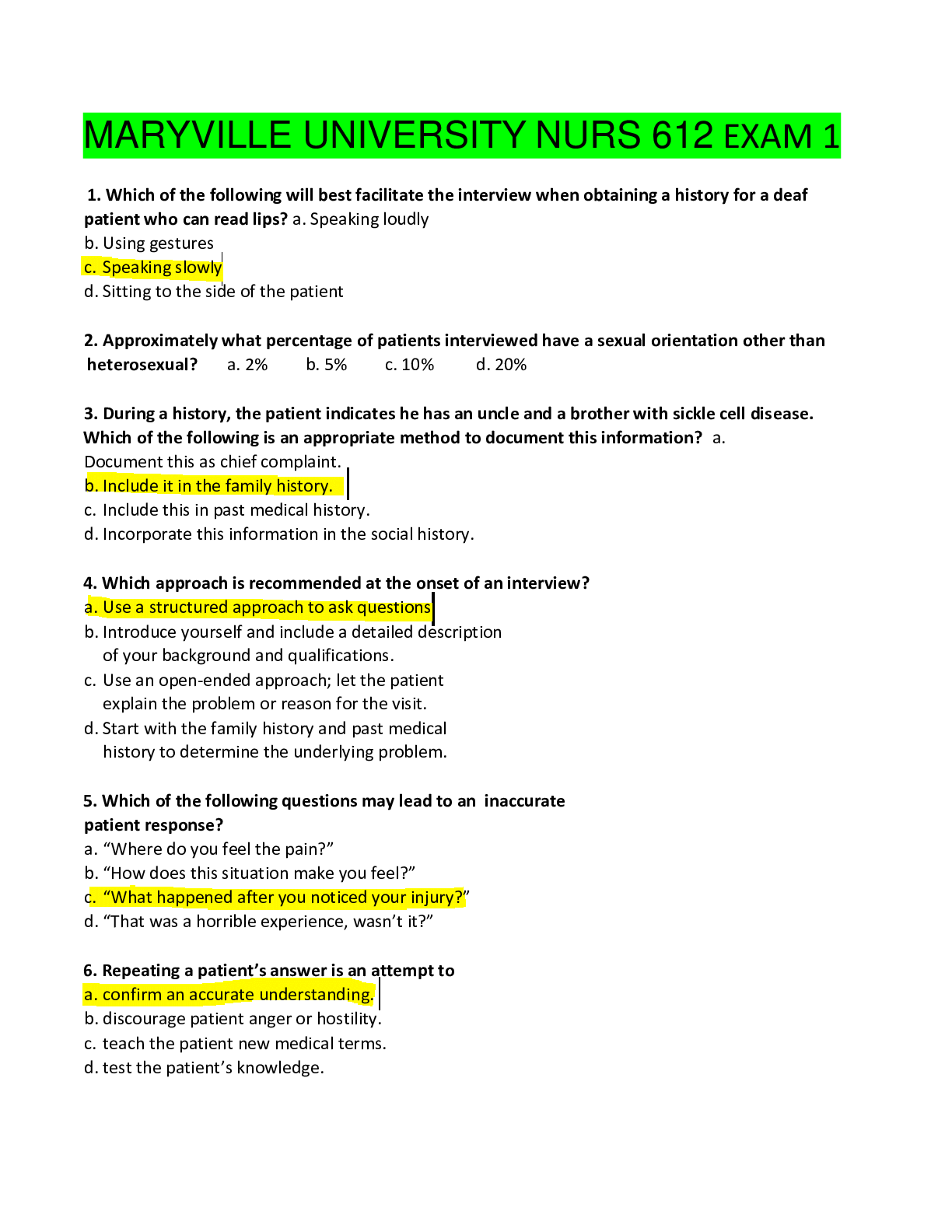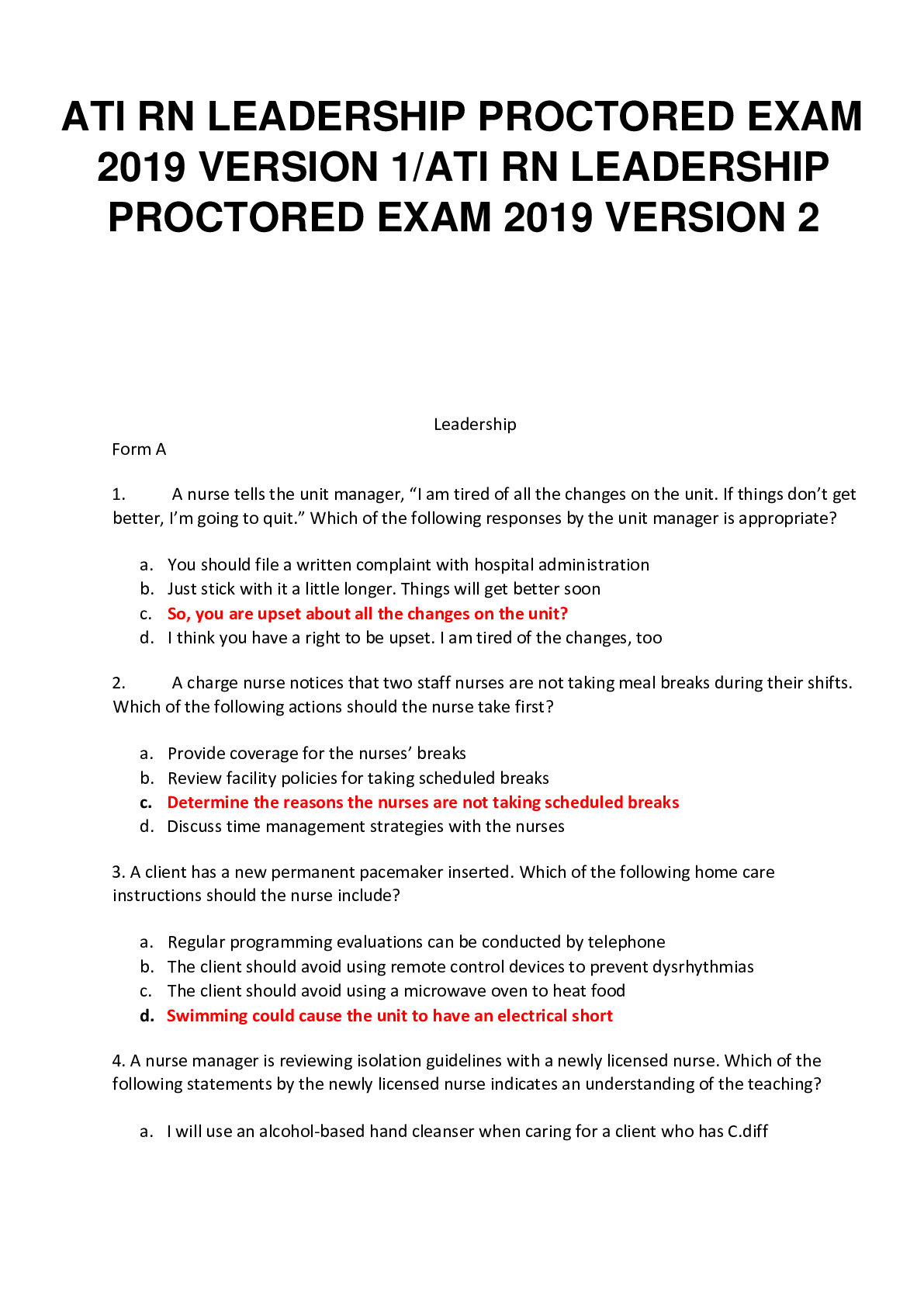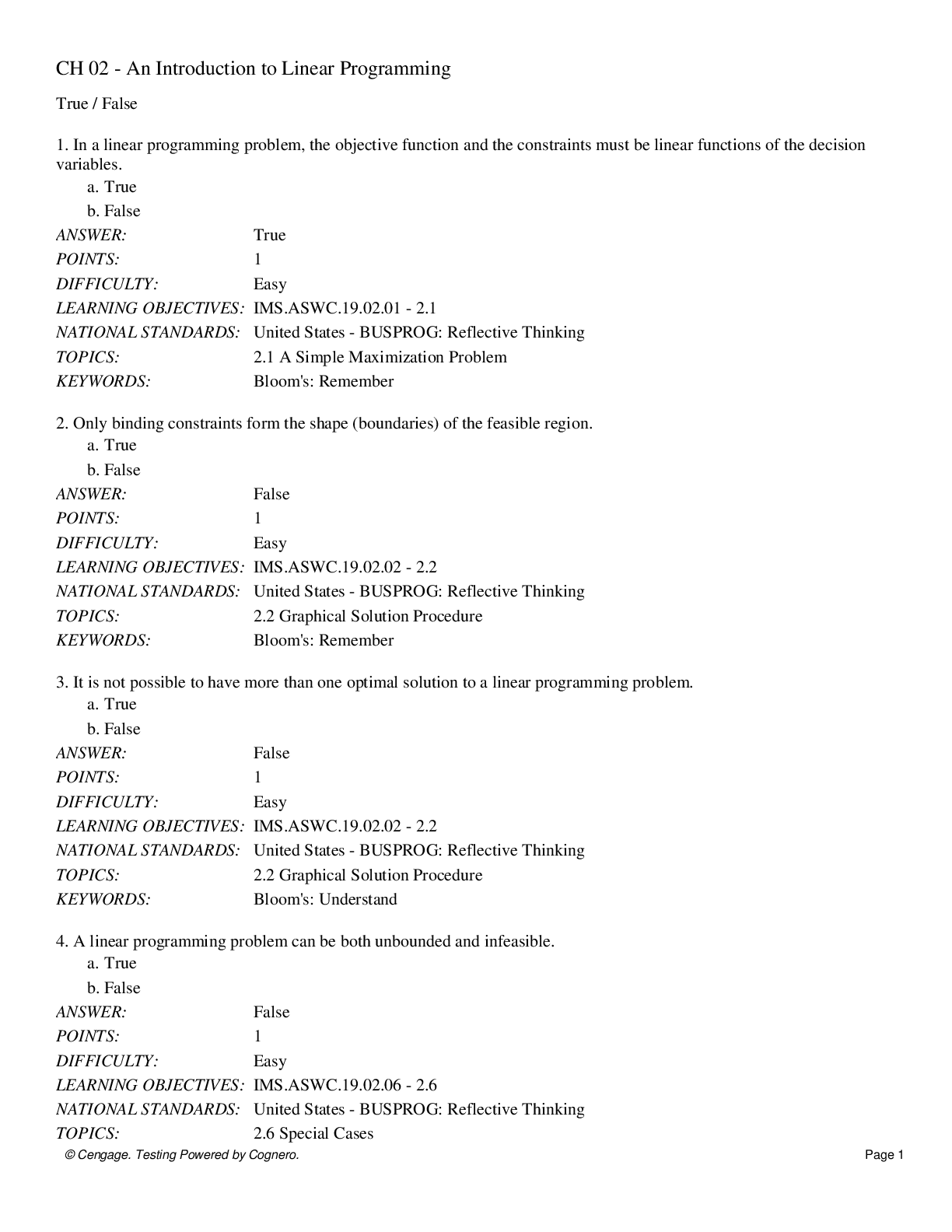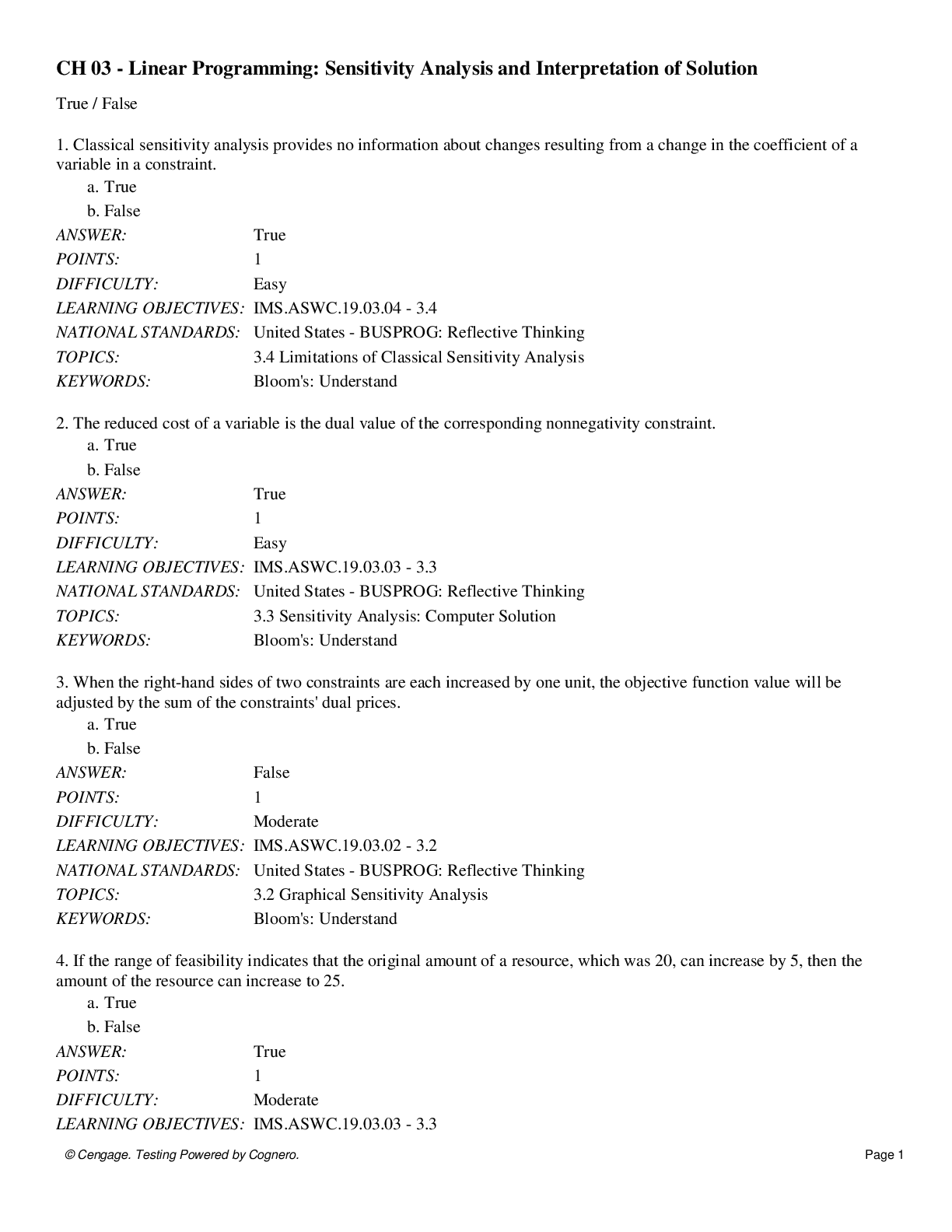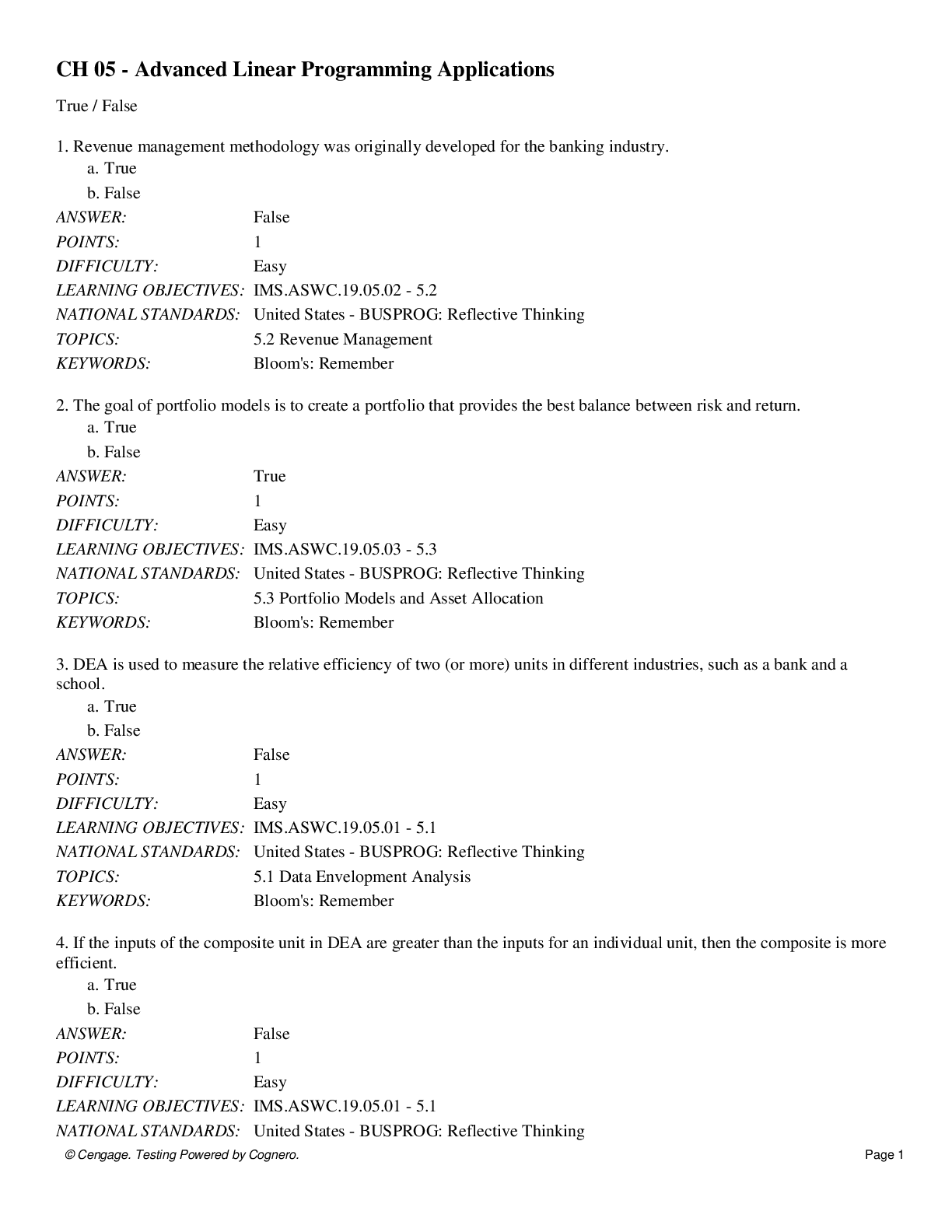Sociology > QUESTIONS & ANSWERS > SOCS 185 WEEK 8 FINAL QUESTIONS AND ANSWERS WITH PLEASANT ANSWERS 2021 (All)
SOCS 185 WEEK 8 FINAL QUESTIONS AND ANSWERS WITH PLEASANT ANSWERS 2021
Document Content and Description Below
SOCS 185 WEEK 8 FINAL QUESTIONS AND ANSWERS WITH PLEASANT ANSWERS Question 1 5 / 5 pts (TCO 8) _____ is the incidence of childbearing in a country’s population, while _____ refers to maximum po... ssible childbearing. Fertility; fecundity Active fertility; childbearing potential Birth rate; population growth Fertility; childbearing potential Fecundity; fertility Chapter 15 Question 2 5 / 5 pts (TCO 8) The concept environmental deficit refers to long-term harm to the environment caused by a short-sighted focus on material affluence. the fact that too few people are engaged in the study of the natural environment. the fact that natural scientists ignore the social dimensions of environmental problems. a lack of environmental surplus over an extended period of time. efforts to protect the environment to benefit future generations. Chapter 15 Question 3 5 / 5 pts (TCO 3) Max Weber’s thesis on the Protestant ethic and the spirit of capitalism highlighted the importance of which of the following in the process of social change? Invention Ideas Social conflict Cultural diffusion Discovery Chapter 16 Question 4 5 / 5 pts (TCO 3) What is an appropriate criticism of the Logic of Growth arguments? It is by no means logical. It ignores the globally dramatic increase in population. It is unnecessarily pessimistic. It assumes that natural resources will always be plentiful. No logic, no growth; know logic, know growth. Chapter 15 Question 5 5 / 5 pts (TCO 8) Which English economist and clergyman warned that rapid population increase would lead to social chaos? Fredrick Engles Thomas Robert Malthus Les Ismore Paul Ehrlich Ralph Nader Chapter 15 Question 6 5 / 5 pts (TCO 3) What is a criticism that is sometimes made of Weber’s work? The inequality he attributed to alienation actually stems from social bureaucracy. The bureaucracy he attributed to alienation actually stems from social inequality. The inequality he attributed to bureaucracy actually stems from social alienation. The alienation he attributed to bureaucracy actually stems from social inequality. The bureaucracy he attributed to inequality actually stems from social alienation. Chapter 1 Question 7 5 / 5 pts (TCO 3) Which term is used by sociologists to refer to organized collective activities that encourages or discourages social change? Social movements Social groups Power movements Pressure groups Lobbying group Chapter 16 Question 8 5 / 5 pts (TCO 8) Medical science can keep a person’s body alive, on machines, long after their vital organs have failed. However, there is no agreement among religious and ethical leaders about how to decide when to unplug those machines. This example illustrates _____. Material culture Nonmaterial culture Cultural relativity Culture shock Culture lag Chapter 16 Question 9 5 / 5 pts (TCO 3) David Riesman described other-directed social character as which of the following? Openness to the latest trends and fashions Rigid conformity to established ways of life Being highly individualistic Helping others before helping yourself Unique Chapter 16 Question 10 5 / 5 pts (TCO 8) Of the various types of social movements, which is least threatening to the status quo? Alternative social movements Redemptive social movements Reformative social movements Revolutionary social movements Reactionary social movements Chapter 16 Question 11 40 / 40 pts (TCOs 1, 2, 3, and 4) Describe and give an example of each of sociology’s three research orientations. Your Answer: Positivist Sociology creates an orderly system using the structural-functional approach. This means that all the different aspects of the society work together. Researchers carefully observe behaviors to gather data as a neutral observer. An example of this research in real world example would be the study of race and social issues connected to it. This approach to the topic would illustrate things like education trends, income levels, or unemployment rates in the different races. All of these things can be researched using facts and statistics to provide a factual data about the differences. Interpretive Sociology creates ongoing interaction using the symbolic-interaction approach. This means that the society is created from the everyday interactions of its people. Researchers focus on subjective meaning of behaviors as a participant. Using the same example of race and social issues connected to it, this approach would look at the interactions. There would be interviews with the different groups of different races and any authority levels as well as to determine what interactions are causing the different social issues between the races. Critical Sociology creates patterns of inequality where groups of people dominate others using the social-conflict approach. This means that the inequalities create the conflict which leads to change. Researchers use the research to bring about social change as an activist. Using the same example with this approach, the researcher would see that there are social issues created by race and bring attention to the differences to gather support in working towards a change. Like a march or a protest with the ultimate goal of changing what is happening instead of trying to figure out why it is happening. Chapter 1. Answer should include the following: positivist sociology, based on science; interpretive sociology, based on the meanings that people attach to behavior; and critical sociology, based on bringing about social change. Question 12 40 / 40 pts (TCOs 3 and 8) You have been asked by a committee of student success coaches to investigate why the rate at which freshman students post to their course threaded discussions is lower than the rate for other groups of students. Explain how the symbolic-interactionist perspective would analyze and explain the low posting rate. (In other words, consider the contributing factors that the symbolic-interactionist perspective would focus on in trying to explain the reasons for the low rate of students posting to their threads.) Then discuss a solution that an interactionist might use to encourage freshman students to post. Your Answer: The symbolic-interactionist perspective would analyze why the discussion posting is low based on the meaning of the situation that is created. It would describe how freshmen are new on campus and have freedoms for the first time in their life. Discussion posts, while important, make up only a small portion of the grade which makes them inconsequential in the eyes of many freshman and as they bond and make friends, that concept is passed around. They believe that they will do well in the class without spending the extra time a few nights a week, to post in the discussions. So the fact that they are seen as inconsequential overrides the fact that they are graded. An interactionist might advocate for programs at orientation that allow freshman a chance to bond with upper classmen, allowing the interaction with students who have been around longer and understand the importance of posting in the discussions. Chapter 1 covers the basic elements of the core sociological theories. In addressing the first part of this question, students will need to demonstrate that they understand the basic ideas and concepts of interactionist theory. In addressing the second part of this question, students will need to demonstrate that they can offer a solution to the problem based on interactionist theory. Question 13 40 / 40 pts (TCOs 6 and 7) Identify and define the four stages in the life course of a social movement. Your Answer: The first stage is emergence. This is the beginning stage, so there is likely little to no organization. This stage is most often referred to as widespread discontent. The second stage is coalescence. This is when the discontent starts to be defined. There is likely a reason behind the feeling of discontent and/or someone who is responsible for it. There is more organization and strategics. The third stage is bureaucratization. This is when there has been some success and there are raising awareness for the issue. There is great organization and usually someone in charge and likely staff personnel as well. Political power is increased and this is the time to truly make changes. The fourth stage is decline. This doesn't always mean failure, though sometime it does. A social movement can succeed which will put it into the decline stage. Other ways that it can go into decline include repression, where the authorities use measures to control or destroy the movement or co-optation, where the group leaders start associating more with the targets of the movement than with the movement itself. Chapter 16. Answer should include the definitions of emergence, coalescence, bureaucratization, and decline. Question 14 40 / 40 pts (TCOs 3, 4, and 6) Identify and describe the three leadership styles. Provide examples of these styles in society. Your Answer: Authoritarian leaders rule their groups. They make the decisions that they think are best. This leadership style can be beneficial, however, that amount of power is usually abused. This leadership style can also lead to resentment of the leader by the members of the group. An example of this leadership style would be Adolf Hitler in Germany. The people did what he wanted and had no choice in the matter. This is also a good example of an abuse of the power from this position. Democratic leaders try to include everyone in the decision-making process. They implement what the members want. They often lack a formal position and real power. They have to remain accountable to the members of the group. An example of this leadership style can be seen in some businesses. When the management asks the employees for suggestions on ways to improve, considers all employees inputs before implementing new policies or when voting on matters that mean the most the to the employees. Laissez-faire let the group function without much interference. They are mainly just leaders in name. This is more equivalent to an absence of a leader. This leadership style is not often the appropriate choice, since it is often lacking in direction, feedback and praise. A good example of this would be scientists in a lab. There is a leader that they turn to for funding or other issues, but for the most part, they work with little to no supervision. Chapter 5 Question 15 40 / 40 pts (TCOs 5, 6, and 8) Identify the four patterns of majority/minority interaction. Discuss the defining characteristics of each pattern, and provide an example for each. Your Answer: Pluralism is when all the races and ethnicities have an equal role in society even though they are each different. Social groups can interact in both positive and negative ways. America is a great example of this pattern of interaction. There are so many different social groups, and when it is time to vote, everyone has an equal say. Assimilation is when the subordinate group either voluntarily or forcefully adopts the cultural traits and beliefs of the dominant group. A good example of this is the use of R.S.V.P. on an invitation. This comes from the French term repondez s'il vous plait which loosely translated means please respond. Even though it is a French term, it has been assimilated into American life. Segregation is when there is either physical or social separation of the groups of people. A good example of this is back in the 1950s and earlier when African Americans had their own schools and restrooms and were forced to sit in a different part of the bus than Caucasians. They were completely segregated, in practice and with laws. Genocide is when one group of people systematically kills off another group of people. A very popular example of genocide is when Adolf Hitler and the German Army tried to systematically kill off all the Jewish people in Germany by forcing them to concentration camps where they were killed. Chapter 11. Students should provide a definition pluralism, assimilation, segregation, and genocide and then provide an example. For example, an example of genocide would be the extermination of European Jews by the Nazis during World War II. An example of segregation would be the Amish in the United States. [Show More]
Last updated: 1 year ago
Preview 1 out of 8 pages
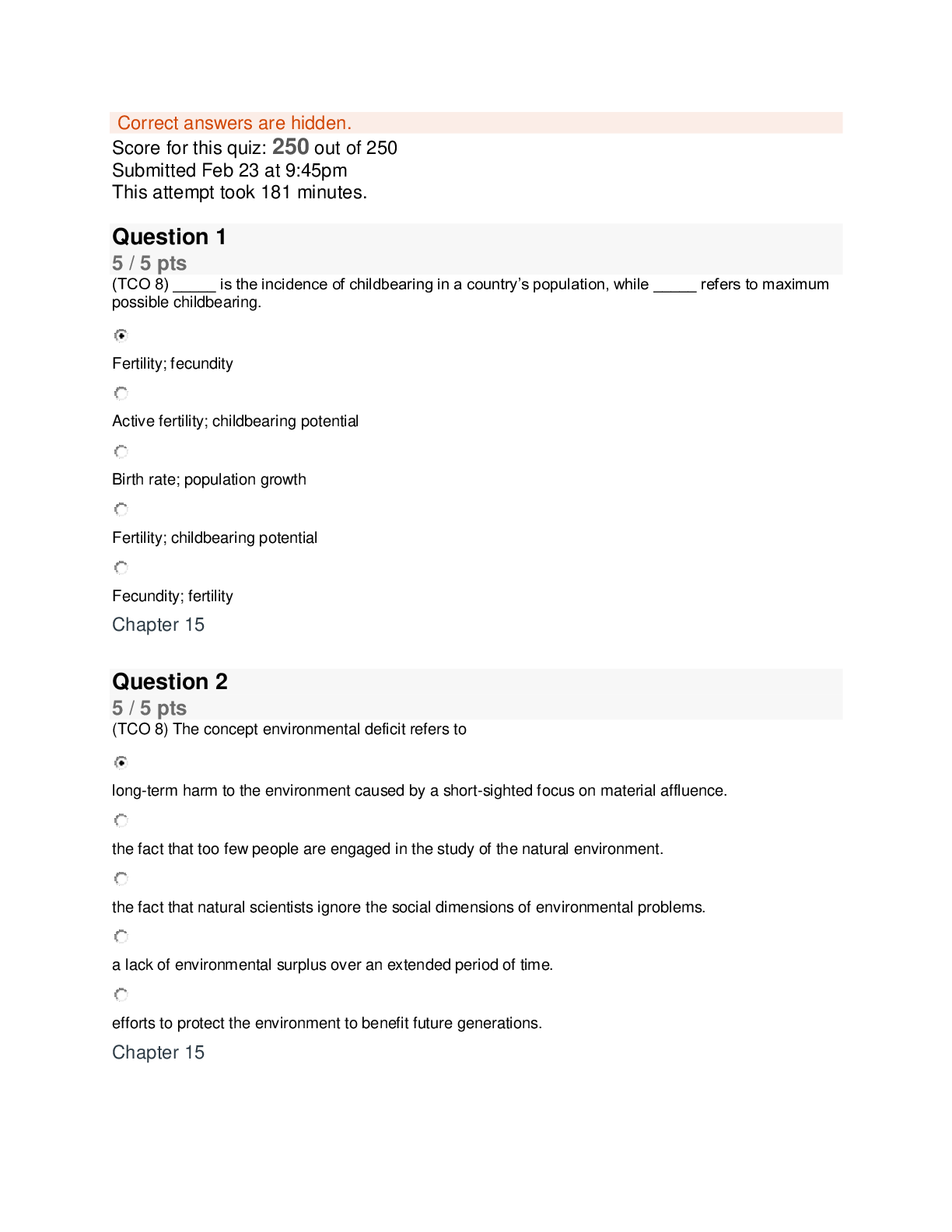
Buy this document to get the full access instantly
Instant Download Access after purchase
Add to cartInstant download
We Accept:

Reviews( 0 )
$8.00
Document information
Connected school, study & course
About the document
Uploaded On
Jan 08, 2021
Number of pages
8
Written in
Additional information
This document has been written for:
Uploaded
Jan 08, 2021
Downloads
0
Views
53


